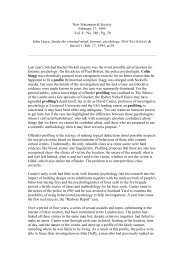Explanations of Criminal behaviour - Jeff Standen
Explanations of Criminal behaviour - Jeff Standen
Explanations of Criminal behaviour - Jeff Standen
Create successful ePaper yourself
Turn your PDF publications into a flip-book with our unique Google optimized e-Paper software.
evidence suggests that black people are indeed treated unequally within criminal justice processes, but the<br />
differential in imprisonment rates is said by some to be the result <strong>of</strong> higher crime rates among black people<br />
(Wilbanks, 1987). Reiner (1993) argues that methodological flaws beset any attempt to provide rational<br />
explanations <strong>of</strong> the differences in crime rates and imprisonment rates, and that it is still possible to argue that<br />
black crime is partially the result <strong>of</strong> white racism.<br />
While some have suggested that blacks are more likely to be involved in crime because <strong>of</strong> genetic inferiority<br />
(Rushton, 1990), it is clear that a more likely explanation lies in the sub-culture <strong>of</strong> violence and social<br />
disadvantage which many black people share, and institutional racism within the criminal justice system. Racial<br />
discrimination undoubtedly limits the educational and occupational opportunities available to ethnic minorities,<br />
and there are biases operating in the legal processing <strong>of</strong> <strong>of</strong>fenders which work against black people. These biases<br />
appear to be remarkably resistant to intervention, despite the findings <strong>of</strong> the 1999 Stephen Lawrence enquiry.<br />
WHY IS GENDER IMPORTANT IN EXPLANATIONS OF CRIME?<br />
Probably the most significant feature <strong>of</strong> both recorded and self-reported crime is that more males than females<br />
commit <strong>of</strong>fences. This is particularly true for violent crime, in spite <strong>of</strong> claims that women are becoming more<br />
aggressive (Krista, 1994), or that, because <strong>of</strong> their inherent deviousness, they have always been more criminal but<br />
have simply been able to conceal it (Pollak, 1950). In 1997 only 1 T% <strong>of</strong> known <strong>of</strong>fenders were women, and it is<br />
estimated that only 8% <strong>of</strong> women have a conviction by the age <strong>of</strong> 40, compared with 34% <strong>of</strong> men (Home Office,<br />
1999). There have also been suggestions that the criminal justice system is more 'chivalrous' towards females, and<br />
thus the gender difference is not as large as would appear from <strong>of</strong>ficial figures (Hedderman and Hough, 1994),<br />
although self-report studies bear out the differential (Hindelang, 1979). Most explanations <strong>of</strong> the gender gap in<br />
crime draw on accepted differences between males and females such as dominance, aggression, physique and<br />
nurturance. Others point to female socialisation which tends to be characterised by greater parental supervision,<br />
more stress on conformity, and fewer opportunities for crime. Those females who do deviate are viewed as<br />
having not only rejected society's rules but the traditional female role too, and are described as showing 'double<br />
deviance' while risking 'double jeopardy' (Heidensohn, 1995). In fact Lombroso and Ferrero (1895) suggested<br />
that criminal women were rare, but those who had not been 'neutralised by maternity' were likely to become even<br />
worse criminals than men. Criminology has notoriously ignored the issue <strong>of</strong> gender, preferring to <strong>of</strong>fer universal<br />
theories <strong>of</strong> crime based on empirical work which has relied only on male subjects. As Cain (1989) points out:<br />
Men as males have not been the objects <strong>of</strong> the criminological gaze. Yet the most consistent and dramatic<br />
findings from Lombroso to post-modern criminology is not that most criminals are working-class ... but<br />
that most criminals are, and always have been, men. (p.4)<br />
It was not until the 1970s that feminist criminologists such as Heidensohn (1968) and Smart (1977) began to<br />
point out this gross oversight. Since then there have been significant developments in the area, with calls to<br />
'feminize' socialisation in an attempt to reduce crime and to ascertain why females tend to conform rather than<br />
searching for why males <strong>of</strong>fend (Heidensohn, 1995); and suggestions that 'masculinity' itself should be examined<br />
more closely in order to understand why so many young men commit <strong>of</strong>fences and are also the victims <strong>of</strong> crime<br />
(Messerschmidt, 1993; Newburn and Stanko, 1994; Walklate, 2001). As Wilson and Hermstein (1985) observe:<br />
Crime is an activity disproportionately carried out by young men living in large cities. There are old<br />
criminals, and female ones, and rural and small town ones, but to a much greater degree than would be<br />
expected by chance, criminals are young urban males. (p.26)<br />
The fact that over 80% <strong>of</strong> all <strong>of</strong>fenders are male (Home Office, 1999), and that this pattern is repeated<br />
internationally, inevitably begs the question that many criminologists have hitherto avoided asking - what is it<br />
about the cultural history and social construction <strong>of</strong> masculinity which ensures that so many young men become<br />
involved in crime? One <strong>of</strong> the most useful analyses <strong>of</strong> masculinity in relation to crime has come from theorists<br />
using the concepts <strong>of</strong> psychoanalysis and object-relations theory in an attempt to place psychic processes within a<br />
social context. Frosh (1994) draws on the work <strong>of</strong> Nancy Chodorow (1978), and argues that the process <strong>of</strong><br />
separation in early childhood is different for girls and boys, and that while girls may be left with the problem <strong>of</strong><br />
achieving independence and self-esteem, boys are left with an ambivalence towards women and commitment







